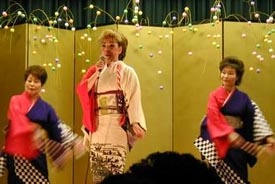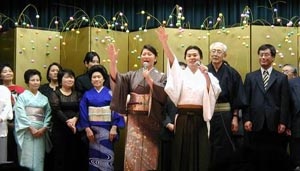This article was written in 2003. I haven’t judged the Kohaku Utagassen contest since then, but I’ve attended the event most years. It’s still a tradition for Denver’s Japanese-speaking community, and a showcase for the older generation’s treasured “enka” style of pop song.
This weekend I discovered that karaoke can be incredibly elegant, and a legitimate form of entertainment—not just bar fodder.
I was a judge for the 28th annual Red vs. White Singing Competition, Denver’s professionally-staged version of Japan’s Kohaku Utagassen contest. In Japan, Kohaku Utagassen is an institution. It’s an annual contest between women (red team) and men (white team) during which the men and women take turns singing a song and the team with the highest score for the evening takes home the trophy for a year. The contest has been broadcast live on New Year’s Eve since 1951, first on radio and since 1953, on TV. At its peak, Kohaku Utagassen was Japan’s television equivalent of the Super Bowl in America.
Over the years, the program in Japan has featured the entire variety of popular music in Japan, which seems to include everything side-by-side from traditional folk styles to the pop music of my parents’ generation and more recently, the rock sounds of modern “jpop.”
That’s part of the challenge facing Denver’s own Kohaku Utagassen held every year at the Denver Buddhist Temple. Although it’s a well-attended event, the organizers (this year’s chairman was John Kanegaye) are keenly aware of a looming generation gap. The contest has appealed largely to the older Japanese-speaking community, which turns out faithfully every year to see a core of performers who also turn out every year. So Kanegaye has recruited some younger singers to perform contemporary songs, as well as getting some new blood (like me, and Japan America Society of Colorado executive director Naomi Asada, among others) to be judges.
Once the music began, the rhythms, melodies and emotions took over, and language hardly mattered.
I was confident that I could judge Japanese pop styles fairly—after all, I had grown up with the sound of my parents’ Japanese reel-to-reel tapes, and although I may not have been familiar with the songs or the performers, the music wasn’t foreign to me.
What was foreign to me, however, was the language. Of the 10 judges, I was the sole non-Japanese speaking one. Tadayoshi Imamura, the energetic master of ceremonies for the afternoon-long affair, ambled up to me before the start and apologized that all the speaking during the contest would be in Japanese only. He wondered if I would be all right with that, and if I would have any trouble during the introductions when he pointed out the judges.
As it was, I managed all right with the introduction, and even understood some of the jokes from the stage. The rest of the time, I laughed when others laughed and clapped when others clapped. It was the most completely Japanese environment I had found myself in without actually being in Japan.
Besides, once the music began, the rhythms, melodies, and emotions took over, and language hardly mattered. This was extreme karaoke, not just the off-key warbling you might hear in a bar. The contestants took their performances seriously.
Because Erin had been asked to perform this year (she was a regular in the contest for years but stopped a decade a go), I got to see many of the singers during the four weeks of practices leading up to the contest. So I was already familiar with—and impressed with—the performers. (Full disclosure statement: I offered to abstain when Erin sang her song, but I was told that would throw off the vote count, so I simply voted as honestly as I could. I didn’t give her a perfect score.)
A handful of the singers are members of the Buddhist Temple’s Kayo Club, which meets regularly to hone their karaoke skills. A couple were clearly professionals, including Souichi Nakamura, the white team captain who works in international trade for the Mitsui company but performed as a solo all his life, and Emi Akiba, the red team captain, who teaches piano in the area. A number of the more experienced contestants were from Colorado Springs, where Kanegaye and his wife Michiye live (the couple also performed). The rest were inspired amateurs balancing their nervousness with professionalism.
A handful of songs were very traditional, featuring an old-fashioned nasal singing style performed in kimono. Mihono Uehara sang a traditional obon, an upbeat festival dance song, “Kawachi Otoko Bushi,” with incredible gusto in a kimono, backed by four women dancing along to the irresistible beat.
Deputy Consul General Toshio Ikeda, who had just recently been posted to Denver, put his all into a popular song, “Omae to Ikiru.” Enka, the blues-like adult pop music of Japan that was the style my parents listened to, was well-represented with Hisako Maben’s “Chindo Monogatari” being a great example with its swelling orchestration. Kazuko Nakayama also sang a mature pop song that oozed with sad sexuality, “Kohan no Yado.” Seeing her in her glamorous outfit, she would have fit in Las Vegas during the 1960s…if Vegas were in Japan.
Shigeo Kimura sang what sounded to me like an early, 1950s rock-and-roll song, “Soemoncho Blues,” but he assured me it was from the 1970s. Likewise other songs sounded very old-fashioned to me but they turned out to be recent hits in Japan.
One old song was done up in an obvious contemporary style, a nod to the younger generation’s interest in Kohaku Utagassen. “Shima uta,” a traditional Okinawan song with a difficult melody that swings all over the scale, was given a rousing take by Keiji Kozu.
The only English-language song was sung by Koichi Iwai, the young executive chef for Sushi Zanmai in Boulder. Diners there will notice him limping in the days to come—he hurt his leg while doing the splits during the 1980s Lionel Richie hit, “All Night Long.” He performed it with gusto, though, and earned points by jumping into the audience and dancing with an older woman during the song.
The best performances of the day, not surprisingly, were by the team captains, who also did a terrific job as hosts, introducing their team members and improvising throughout the day. Akiba’s powerful voice soared with the beautiful melody of “Kawa No Nagare No Yo Ni,” and Nakamura brought the house down with his moving performance of “Ohkina Furodokei,” a popular song in Japan that was originally an old American folk song for children, “Grandfather’s Clock.”
The performances overall were so strong, it was difficult to predict which team would win after all 26 performances were over. The women won by only 12 points.
The next night as I watched the Super Bowl entertainment, I realized that Kohaku Utagassen wasn’t so different from America’s biggest viewing event. There now is so much entertainment broadcast before, during, and after the big game that I was able to watch quite a bit of karaoke, American-style—in the US, it’s called lip-synching to backing tracks. I wish though that American pop culture had room for the kind of variety that Japanese cultures allows.
It would have been great to hear a big-band song, or a Frank Sinatra-era crooner, alongside the performances by Santana, Dixie Chicks, Bon Jovi, and Shania Twain.
* This article was originally published on NIKKEI VIEW: The Asian American Blog on January 27, 2003.
© 2011 Gil Asakawa








